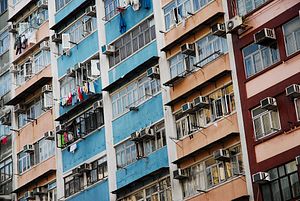In spite of the Hong Kong government’s efforts to put downward pressure on housing prices in recent months, the cost of housing, in terms of both purchase price and rentals, continues to climb. This spells bad news for the city’s poorest, who have been forced to look for alternative living arrangements.
While Hong Kong’s cage homes have often been a source of artistic empathy for foreign photographers, there is one other form of accommodation that is very ubiquitous in Hong Kong — subdivided flats.
Subdivided flats are residential units that have had their original internal non-structural walls removed, and new walls installed to subdivide the original space into separate living quarters. On average, one unit will be split into three to four separate living quarters, usually with independent electricity and water supplies, and a standalone bathroom for each unit. According to the government’s Thematic Household Survey Report No. 60, the average size is equivalent to 62.4 square feet per capita.
These subdivided units are then each rented out individually for a fraction of the price of the whole apartment, but yield a comparatively higher rental income on a per-square-foot basis. They are neither legal nor illegal; technically, as long as a tenancy agreement is in place, then any landlord can rent out a part of their apartment. It has been estimated that there are more than 25,000 units which have been subdivided into almost 89,000 separate living quarters in Hong Kong, constituting 3.8 percent of all units in the city.
Subdivided flats, for which a grey market has flourished for decades, have traditionally been a source of accommodation for the city’s poorest. Rents for subdivided flats have been climbing over the past 20 years. From 2014 to 2015, average rental yields for subdivided flats increased by almost 11 percent, according to the government survey. Now it seems the large property developers are getting in on the action.
In 2016 alone, three high-profile projects have been launched. Each development offer stand-alone living quarters as tiny as 163 square feet. But the tiny size doesn’t come with a tiny price tag. The 163 square-foot apartment will set you back HK$3.9 million or US$502,652 as at end of 2016.
Developers have argued that there is a demand for small apartments in urban areas and the development of the pint-sized units are an effective way to increase the supply, in line with current government promises. In fact, while the Hong Kong government has not explicitly encouraged tiny flats, they have not discouraged such developments either. In fact, the government’s land policy has encouraged developers to build high-rise apartments in already dense urban residential areas on tiny strips of land as small as 5,300 square feet in order to meet its target of 480,000 new homes.
In late October of 2016, a Hong Kong developer lodged an application plan for a project in the ritzy neighborhood of Happy Valley. The plans revealed the new development would offer units of 61.4 square feet – which is marginally smaller than that of the average subdivided flat. It is becoming apparent that this is something of a normalization of small flats in Hong Kong. It will not bode well for the city’s working class.

































